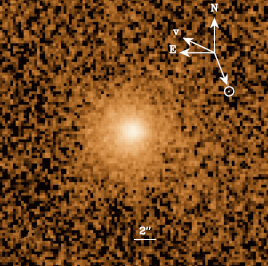Since the dynamical association of the Apollo-type asteroid (3200) Phaethon
with the Geminid meteor shower was made two decades ago, another 10 active asteroids have been discovered. Some originate in the main asteroid belt and thus are known as main belt comets (MBCs), one of the last discovered being P/2012 T1 (PANSTARRS).
Thanks to the possibility of target-of-opportunity observations at the WHT and GTC, a team of Spanish astronomers followed up its evolution and revealed the origin of its cometary activity.
The ejection of dust from P/2012 T1 has likely been sustained over time, and not produced by an impulsive event such as collision between two asteroids. The activity lasted for a period of 4–6 months, with a total ejected dust mass of the order of 6–25×106 kg, for maximum particle sizes 1–10 cm. The activity pattern seems to be compatible with that produced by grains being dragged out from the asteroid surface by sublimating ices. The onset of the activity could have occurred either suddenly near perihelion time, or could have been triggered about a month earlier, and progressed more gradually. The authors of this research favor the second scenario. Similar results were obtained for two other MBCs (P/La Sagra and 176P) but the current MBC database is still small to establish any firm link between them and P/2012 T1.
 |
The image of the main belt comet P/2012 T1 (PANSTARRS) observed with the WHT PFIP camera
on 12/13 November 2012, total exposure 280s. The scale, velocity vector, direction of the Sun, and astronomical north and east are indicated [ PNG ]. |
The team modelled the cometary dust tail using a few hours of observations from the William Herschel Telescope (WHT) and the Gran Telescopio Canarias (GTC) during 6 nights from November 2012 to February 2013. Thanks to the rapid response provided by the ING Service Program, P/2012 T1 was observed first at the WHT using the PFIP imaging camera for about 20 minutes
on 12/13 November 2012, confirming the coma activity of this MBC. Deeper GTC follow-up observations confirmed the results from the PFIP image a few days later, and monitoring of the activity during 4 more GTC nights followed. Finally, two more hours of Spanish CAT DDT time were awarded to use both ACAM and LIRIS on the WHT on 27/28 Feb 2013, confirming the fade of the object to below the detection limit of ACAM and LIRIS, and consistent with the GTC data.
More information
F. Moreno, A. Cabrera-Lavers, O. Vaduvescu, J. Licandro and F. Pozuelos, 2013, "The dust environment of main-belt comet P/2012 T1 (PANSTARRS)", ApJ Letters, 770, L30. Paper.



